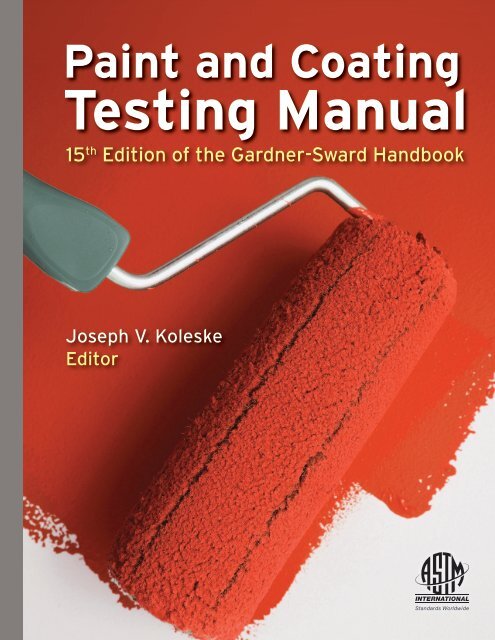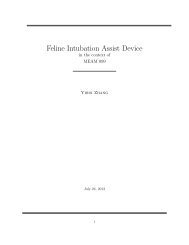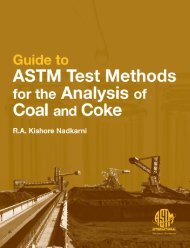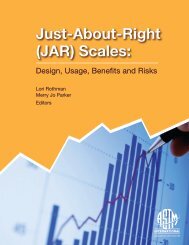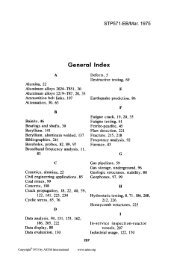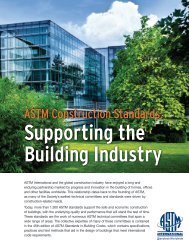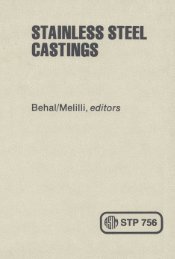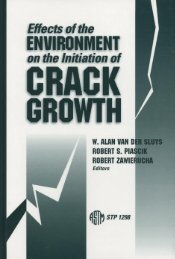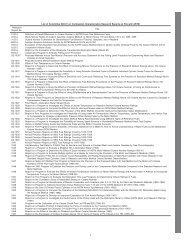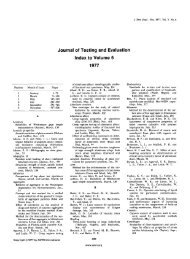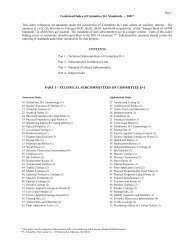Paint and coating testing manual - ASTM International
Paint and coating testing manual - ASTM International
Paint and coating testing manual - ASTM International
Create successful ePaper yourself
Turn your PDF publications into a flip-book with our unique Google optimized e-Paper software.
<strong>Paint</strong> <strong>and</strong> Coating<br />
Testing Manual<br />
15 th Edition of the Gardner-Sward H<strong>and</strong>book<br />
Joseph V. Koleske<br />
Editor
<strong>Paint</strong> <strong>and</strong> Coating<br />
Testing Manual<br />
Fifteenth Edition of the Gardner-Sward H<strong>and</strong>book<br />
Joseph V. Koleske, EDITOR<br />
<strong>ASTM</strong> Stock Number, MNL17-2ND<br />
<strong>ASTM</strong> <strong>International</strong><br />
100 Barr Harbor Drive<br />
PO Box C700<br />
West Conshohocken, PA 19428-2959<br />
Printed in U.S.A.
ii<br />
Library of Congress Cataloging-in-Publication Data<br />
<strong>Paint</strong> <strong>and</strong> <strong>coating</strong> <strong>testing</strong> <strong>manual</strong> : 15th edition of the Gardner-Sward<br />
h<strong>and</strong>book / Joseph V. Koleske [editor].<br />
p. cm.<br />
“<strong>ASTM</strong> Stock Number: MNL17-2nd”<br />
ISBN 978-0-8031-7017-9<br />
1. <strong>Paint</strong> materials—Testing. 2. <strong>Paint</strong> materials—Analysis. I.<br />
Koleske, J. V., 1930-<br />
TP936.5.P34 2011<br />
667'.60284—dc23<br />
2011034983<br />
Copyright © 2012 <strong>ASTM</strong> <strong>International</strong>, West Conshohocken, PA. All rights reserved. This material may not be reproduced<br />
or copied, in whole or in part, in any printed, mechanical, electronic, film, or other distribution <strong>and</strong> storage media,<br />
without the written consent of the publisher.<br />
Photocopy Rights<br />
Authorization to photocopy items for internal, personal, or educational classroom use of specific clients is granted by<br />
<strong>ASTM</strong> <strong>International</strong> provided that the appropriate fee is paid to <strong>ASTM</strong> <strong>International</strong>, 100 Barr Harbor Drive, PO Box<br />
C700. West Conshohocken, PA 19428-2959, Tel: 610-832-9634; online: http://www.astm.org/copyright/<br />
<strong>ASTM</strong> <strong>International</strong> is not responsible, as a body, for the statements <strong>and</strong> opinions advanced in the publication. <strong>ASTM</strong><br />
does not endorse any products represented in this publication.<br />
Printed in Bridgeport, NJ<br />
January, 2012
Contents<br />
Preface ..........................................................................................vii<br />
Introduction ......................................................................................viii<br />
Part 1: Regulations .................................................................................1<br />
Chapter 1—Regulation of Volatile Organic Compound Emissions from <strong>Paint</strong>s <strong>and</strong> Coatings . ....................3<br />
J. John Brezinski <strong>and</strong> Ronald K. Litton<br />
Part 2: Naturally Occurring Materials .................................................................17<br />
Chapter 2—Bituminous Coatings .....................................................................19<br />
Ben J. Carlozzo<br />
Chapter 3—Cellulose Esters of Organic Acids. ..........................................................27<br />
Jos S. de Wit <strong>and</strong> Deep Bhattacharya<br />
Chapter 4—Drying Oils .............................................................................32<br />
Joseph V. Koleske<br />
Chapter 5— Driers <strong>and</strong> Metallic Soaps . ...............................................................38<br />
Marvin J. Schnall<br />
Part 3: Synthetic Materials . .........................................................................47<br />
Chapter 6—Acrylic Polymers as Coatings Binders .......................................................49<br />
John M. Friel <strong>and</strong> Edwin Nungesser<br />
Chapter 7—Alkyds <strong>and</strong> Polyesters ....................................................................65<br />
Dan Nelson<br />
Chapter 8—Amino Resins (Reaction Products of Melamine, Urea, etc., with Formaldehyde <strong>and</strong> Alcohols). ........72<br />
William Jacobs<br />
Chapter 9—Ceramic Coatings. .......................................................................81<br />
Richard A. Eppler<br />
Chapter 10—Epoxy Resins in Coatings . ...............................................................87<br />
Michael J. Watkins<br />
Chapter 11—Phenolics .............................................................................93<br />
John D. Fisher<br />
Chapter 12—Polyamides ............................................................................97<br />
Robert W. Kight<br />
Chapter 13—Polyurethane Coatings . ................................................................102<br />
Han X. Xiao <strong>and</strong> Joseph V. Koleske<br />
Chapter 14—Silicone Coatings ......................................................................113<br />
D. J. Petraitis<br />
Chapter 15—Vinyl Polymers for Coatings .............................................................118<br />
Joseph V. Koleske<br />
Chapter 16—Miscellaneous Materials <strong>and</strong> Coatings ....................................................128<br />
Joseph V. Koleske<br />
Part 4: Plasticizers . ...............................................................................137<br />
Chapter 17—Plasticizers . ..........................................................................139<br />
Peter Tan <strong>and</strong> Leonard G. Krauskopf<br />
Part 5: Solvents . .................................................................................147<br />
Chapter 18—Solvents . ............................................................................149<br />
Stephen A. Yuhas, Jr. <strong>and</strong> Rey G. Montemayor<br />
Part 6: Pigments. .................................................................................183<br />
Chapter 19—White Pigments .......................................................................185<br />
Juergen H. Braun<br />
Chapter 20—Black Pigments. .......................................................................204<br />
Frank R. Spinelli<br />
iii
iv CONTENTS<br />
Chapter 21—Colored Organic Pigments . ..............................................................215<br />
Paul Merchak<br />
Chapter 22—Inorganic Colored Pigments ..............................................................234<br />
Peter A. Lewis<br />
Chapter 23—Ceramic Pigments ......................................................................239<br />
Richard A. Eppler<br />
Chapter 24—Extender Pigments .....................................................................242<br />
Richard A. Eppler<br />
Chapter 25—Metallic Pigments ......................................................................250<br />
Russell L. Ferguson<br />
Chapter 26—Effect Pigments . .......................................................................256<br />
Paul J. Nowak<br />
Chapter 27—Measurement of Gonioapparent Colors . ...................................................272<br />
Allan B. J. Rodrigues<br />
Chapter 28—Protective Coatings <strong>and</strong> Inorganic Anti-Corrosion Pigments ...................................282<br />
Lucien Veleva<br />
Chapter 29—Oil Absorption of Pigments . .............................................................300<br />
Charles W. Glancy<br />
Part 7: Additives ..................................................................................311<br />
Chapter 30—Bactericides, Fungicides, <strong>and</strong> Algicides . ....................................................313<br />
Janet H. Woodward<br />
Chapter 31—Surfactants ............................................................................320<br />
Elvira Stesikova <strong>and</strong> Heinz Plaumann<br />
Chapter 32—Coalescing Aids . .......................................................................332<br />
Kevin W. McCreight<br />
Chapter 33—Thickeners <strong>and</strong> Rheology Modifiers .......................................................341<br />
Gregory D. Shay<br />
Part 8: Physical Characteristics of Liquid <strong>Paint</strong>s <strong>and</strong> Coatings. .............................................373<br />
Chapter 34—Density <strong>and</strong> Specific Gravity. .............................................................375<br />
Raymond D. Brockhaus <strong>and</strong> Ben J. Carlozzo<br />
Chapter 35—Characterizing Particle Size <strong>and</strong> Size Distribution . ...........................................389<br />
George D. Mills<br />
Chapter 36—Rheology <strong>and</strong> Viscometry. ...............................................................415<br />
Richard R. Eley<br />
Chapter 37—Surface Energetics ......................................................................452<br />
Gordon P. Bierwagen, Andrew Huovinen, <strong>and</strong> Bobbi Jo Merten<br />
Chapter 38—Solubility Parameters ...................................................................470<br />
Charles M. Hansen<br />
Part 9: Films for Testing ............................................................................495<br />
Chapter 39—Cure: The Process <strong>and</strong> Its Measurement . ...................................................497<br />
Thomas J. Mir<strong>and</strong>a<br />
Chapter 40—Film Preparation for Coating Tests ........................................................505<br />
Robert D. Athey, Jr.<br />
Chapter 41—Measurement of Film Thickness. ..........................................................514<br />
John Fletcher <strong>and</strong> Joseph Walker<br />
Chapter 42—Drying Time . ..........................................................................528<br />
Thomas J. Sliva<br />
Part 10: Optical Properties . .........................................................................533<br />
Chapter 43—Color <strong>and</strong> Light . .......................................................................535<br />
Robert T. Marcus
CONTENTS v<br />
Chapter 44—Gloss .................................................................................558<br />
Gabriele Kigle-Böckler <strong>and</strong> Harry K. Hammond III<br />
Chapter 45—Hiding Power ..........................................................................569<br />
Leonard Schaeffer<br />
Chapter 46—Mass Color <strong>and</strong> Tinting Strength of Pigments . ..............................................591<br />
Joseph V. Koleske<br />
Part 11: Physical <strong>and</strong> Mechanical Properties ............................................................599<br />
Chapter 47—Adhesion .............................................................................601<br />
Gordon L. Nelson<br />
Chapter 48—Abrasion Resistance ....................................................................615<br />
Daniel K. Slawson<br />
Chapter 49—Dynamic Mechanical <strong>and</strong> Tensile Properties. ................................................624<br />
Loren W. Hill<br />
Chapter 50—Flexibility <strong>and</strong> Toughness ................................................................637<br />
John Fletcher <strong>and</strong> Joseph Walker<br />
Chapter 51— Underst<strong>and</strong>ing Osmotic Activity in <strong>Paint</strong> Films <strong>and</strong> Determining Cause by Systematic<br />
Analysis of Blister Fluids <strong>and</strong> Blistered Coatings . ............................................644<br />
George Mills<br />
Chapter 52—Stress Phenomena in Organic Coatings. ....................................................655<br />
Dan Y. Perera<br />
Chapter 53—Friction <strong>and</strong> Slip Resistance ..............................................................673<br />
Joseph V. Koleske<br />
Part 12: Environmental Resistance. ...................................................................685<br />
Chapter 54—Prevention of Metal Corrosion with Protective Overlayers. ....................................687<br />
William H. Smyrl<br />
Chapter 55—Types of Metal Corrosion <strong>and</strong> Means of Corrosion Protective by Overlayers. .....................697<br />
Kenneth B. Tator <strong>and</strong> Cynthia L. O’Malley<br />
Chapter 56—Accelerated Weathering .................................................................715<br />
Valerie S. Sherbondy<br />
Chapter 57—Chemical Resistance ....................................................................725<br />
Latoska N. Price<br />
Chapter 58—Water-Resistance Testing of Coatings ......................................................731<br />
John Fletcher <strong>and</strong> Joseph Walker<br />
Part 13: Specific Product Testing . ....................................................................737<br />
Chapter 59—Aerospace <strong>and</strong> Aircraft Coatings ..........................................................739<br />
Charles R. Hegedus, Stephen J. Spadafora, Anthony T. Eng, David F. Pulley, <strong>and</strong> Donald J. Hirst<br />
Chapter 60—Architectural Coatings. ..................................................................751<br />
Neal Rogers<br />
Chapter 61—Artists’ <strong>Paint</strong>s. .........................................................................765<br />
Benjamin Gavett<br />
Chapter 62—Can Coatings . .........................................................................770<br />
Joseph V. Koleske<br />
Chapter 63—Testing of Industrial Maintenance Coatings .................................................778<br />
Dwight G. Weldon<br />
Chapter 64—Pipeline Coatings. ......................................................................787<br />
Alfred Siegmund<br />
Chapter 65—Sealants ..............................................................................792<br />
Saul Spindel<br />
Chapter 66—Pavement Marking Materials .............................................................799<br />
James R. Swisher
vi CONTENTS<br />
Chapter 67—Water-Repellent Coatings. ...............................................................807<br />
Victoria Scarborough <strong>and</strong> Thomas J. Sliva<br />
Part 14: Analysis of <strong>Paint</strong> <strong>and</strong> <strong>Paint</strong> Defects ............................................................811<br />
Chapter 68—Analysis of <strong>Paint</strong> . ......................................................................813<br />
Darlene Brezinski<br />
Chapter 69—The Analysis of Coatings Failures .........................................................830<br />
George D. Mills<br />
Part 15: Instrumental Analysis . ......................................................................849<br />
Chapter 70—Atomic Absorption, Emission, <strong>and</strong> Inductively Coupled Plasma Spectroscopy . ....................851<br />
Dwight G. Weldon<br />
Chapter 71—Chromatography .......................................................................856<br />
Rol<strong>and</strong>o C. Domingo <strong>and</strong> updated by Rey G. Montemayor<br />
Chapter 72—Electron Microscopy Overview with Coating Applications .....................................881<br />
David R. Rothbard <strong>and</strong> John G. Sheehan<br />
Chapter 73—Infrared Spectroscopy ...................................................................895<br />
Dwight G. Weldon<br />
Chapter 74—Methods for Polymer Molecular Weight Measurement .......................................908<br />
Thomas M. Schmitt<br />
Chapter 75—Ultraviolet/Visible Spectroscopy ..........................................................914<br />
George D. Mills<br />
Chapter 76—X-Ray Analysis .........................................................................920<br />
A. Monroe Snider, Jr.,<br />
Part 16: Specifications ..............................................................................941<br />
Chapter 77—<strong>Paint</strong> <strong>and</strong> Coating Specifications <strong>and</strong> St<strong>and</strong>ards .............................................943<br />
Joseph V. Koleske<br />
Part 17: New Coating Technology . ...................................................................949<br />
Chapter 78—Radiation Curing of Coatings .............................................................951<br />
Joseph V. Koleske<br />
Chapter 79—Powder Coating. .......................................................................957<br />
Joseph V. Koleske<br />
Appendix ........................................................................................962<br />
Index. ...........................................................................................965
Preface<br />
For historical purposes, it is important to point out that<br />
at a January 1967 meeting of <strong>ASTM</strong> Committee D01 held<br />
in Washington, D.C., the American Society for Testing <strong>and</strong><br />
Materials (<strong>ASTM</strong> <strong>International</strong>) accepted ownership of the<br />
Gardner-Sward H<strong>and</strong>book from the Gardner Laboratory.<br />
It was through this laboratory that Dr. Henry A. Gardner<br />
published the previous twelve editions of the <strong>manual</strong>.<br />
Acceptance of this ownership gave <strong>ASTM</strong> an assumed<br />
responsibility for revising, editing, <strong>and</strong> publishing future<br />
editions of this well-known, respected <strong>manual</strong>. The undertaking<br />
was assigned to “Committee D01 on <strong>Paint</strong> <strong>and</strong><br />
Related Coatings, Materials, <strong>and</strong> Applications.” This committee<br />
established a permanent subcommittee, “D01.19 on<br />
Gardner-Sward H<strong>and</strong>book,” whose stated scope is delineated<br />
below. The 13th edition was published in 1972 as the<br />
<strong>Paint</strong> Testing Manual (STP 500) with Mr. G. G. Sward as<br />
editor <strong>and</strong> contributor. It was updated, exp<strong>and</strong>ed, <strong>and</strong> published<br />
in 1995 as the 14th edition, <strong>Paint</strong> <strong>and</strong> Coating Testing<br />
Manual (MNL 17) with Dr. Joseph V. Koleske as editor <strong>and</strong><br />
contributor. The <strong>manual</strong> has served the industry well in the<br />
past by providing useful information that cannot be readily<br />
found elsewhere.<br />
It has been about fifteen years since the 14th edition<br />
was published. Interest in the <strong>manual</strong> has been strong<br />
through the years. This new edition of the <strong>Paint</strong> <strong>and</strong> Coating<br />
Testing Manual, the Fifteenth Edition of the Gardner-Sward<br />
H<strong>and</strong>book (MNL 17), has been updated <strong>and</strong> exp<strong>and</strong>ed.<br />
The scope of the new edition is in keeping with the<br />
stated scope of Subcommittee D01.19:<br />
To provide technical, editorial, <strong>and</strong> general guidance<br />
for the preparation of the Fourteenth <strong>and</strong><br />
subsequent editions of the Gardner-Sward H<strong>and</strong>book.<br />
The h<strong>and</strong>book is intended for review of both<br />
new <strong>and</strong> experienced paint technologists <strong>and</strong> the<br />
past, present, <strong>and</strong> foreseeable trends in all kinds of<br />
<strong>testing</strong> within the scope of Committee D01. It supplements,<br />
but does not replace, the pertinent parts<br />
of the Society’s Book of St<strong>and</strong>ards. It describes,<br />
briefly <strong>and</strong> critically all Test Methods believed to<br />
have significance in the world of paint technology,<br />
whether or not these tests have been adopted officially<br />
by the Society.<br />
Once again, in this new edition, <strong>ASTM</strong> st<strong>and</strong>ard test<br />
methods, procedures, <strong>and</strong> other documents are described in<br />
minimal detail, with the various volumes of the <strong>ASTM</strong> Book<br />
of St<strong>and</strong>ards remaining the primary source of such information.<br />
An effort was made to include references in the absence<br />
of <strong>ASTM</strong> documents concerning industrial, national, international,<br />
<strong>and</strong> other society test methods. The new edition<br />
contains either new chapters, or the previous topics/chapters<br />
in rewritten/revised form. In a few cases, the previous<br />
edition was merely updated, at<strong>testing</strong> to either the quality<br />
of the earlier writing, the lack of development in the area,<br />
or the apparent waning of interest in the topic. A variety of<br />
modern topics have been included. New chapters have been<br />
added as, for example, “Measurement of Gonioapparent<br />
Colors,” “Surfactants,” “Powder Coating,” <strong>and</strong> “Coalescing<br />
Aids.” As in the previous edition, individual authors, experts<br />
in their particular fields, were given a great deal of freedom<br />
in expressing information about their topics, but all chapters<br />
were subjected to peer review by two colleagues. Thus, style<br />
<strong>and</strong> content presentation may widely vary, but efforts were<br />
made to have underst<strong>and</strong>able syntax <strong>and</strong> thus readers should<br />
find the information useful <strong>and</strong> “easy” to read <strong>and</strong> put to use.<br />
Manuals such at this one are prepared though a great<br />
deal of effort by the various authors <strong>and</strong> through the able<br />
assistance <strong>and</strong> behind-the-scenes concerted efforts of people<br />
such as Ms. Kathy Dernoga <strong>and</strong> Ms. Monica Siperko of<br />
<strong>ASTM</strong> <strong>International</strong> <strong>and</strong> Ms. Christine Urso, Ms. Barbara<br />
Carbonaro, Ms. Theresa Fucito, Ms. Patricia Mayhew, <strong>and</strong><br />
Ms. Benita Hammer, of the American Institute of Physics, all<br />
of whom ensured that the <strong>manual</strong> was uniform in style <strong>and</strong><br />
grammar <strong>and</strong> that manuscripts were submitted <strong>and</strong> processed<br />
in a timely fashion. The real unsung <strong>and</strong> unnamed<br />
contributors are the reviewers who gave encouragement to<br />
the various authors through constructive criticism, editorial<br />
information, <strong>and</strong> recommendations without deleteriously<br />
attempting to alter manuscripts from the author’s intent.<br />
To all of these people, a heart-felt “thank you.” Your talents<br />
have been utilized, you sacrificed much personal time, <strong>and</strong><br />
you were patient with the numerous delays encountered on<br />
the road to making the <strong>manual</strong> a success.<br />
Joseph V. Koleske<br />
Editor<br />
vii
viii<br />
Introduction<br />
PAST TO PRESENT<br />
The previous edition of this <strong>manual</strong>, the 14th, described<br />
in detail the changes that took place in the <strong>coating</strong> industry<br />
from the early 1970s to the early- to mid-1990s. Published<br />
in 1995, the 14th edition classified powder <strong>coating</strong>,<br />
radiation-cured <strong>coating</strong>s, <strong>and</strong> higher-solids <strong>coating</strong>s as<br />
new, with a potentially reasonable growth curve. It noted<br />
that at the time, all liquid <strong>coating</strong>s were at higher solids<br />
content (lower volatile organic solvent content) than in<br />
the 1960s when Rule 66 came into being. Powder <strong>coating</strong><br />
<strong>and</strong> radiation curing were sufficiently new enough<br />
that chapters related to <strong>testing</strong> them were not included<br />
in the <strong>manual</strong>. High-solids development still struggled<br />
with the difficulties of decreasing molecular weight for<br />
low viscosity purposes <strong>and</strong> achieving the low molecular<br />
weight with functionality on all molecules that quality<br />
<strong>coating</strong>s require. However, the solids level has increased<br />
in solvent-based <strong>coating</strong>s <strong>and</strong> achievements have been<br />
realized in decreasing volatile organic content (VOC).<br />
Since that time, powder <strong>coating</strong> has exploded. Today<br />
the technology is well established, has a significant share of<br />
the <strong>coating</strong>s market, is internationally accepted, <strong>and</strong> has a<br />
strong technical society that aids in future growth. To illustrate<br />
the widespread acceptance of powder <strong>coating</strong>s, one<br />
merely needs to look at advertisements. Outdoor metal furniture<br />
advertisements, for example, proudly include words<br />
that imply quality <strong>and</strong> durability—that is to say, “powdercoated<br />
finishes.”<br />
Of course, such furniture certainly is not the only commercial<br />
outlet for powder <strong>coating</strong>s. Applications include<br />
lighting fixtures, tubing <strong>and</strong> aerosol cans, automobile <strong>and</strong><br />
bicycle wheels, rebars, store fixtures, agriculture <strong>and</strong> construction<br />
materials, <strong>and</strong> on <strong>and</strong> on. Initially, colors <strong>and</strong><br />
color changeovers were considered to be a major obstacle<br />
to powder <strong>coating</strong> development, but today a broad variety<br />
of colors is available, including many metallic <strong>and</strong> special<br />
effect finishes with abrasion resistance, brilliance, <strong>and</strong><br />
overall high quality. Powder <strong>coating</strong> provides quality, economy<br />
in manufacturing space, increased production, energy<br />
usage reduction, <strong>and</strong> other facets important to product<br />
development <strong>and</strong> sales in today’s marketplace.<br />
As with powder <strong>coating</strong>, radiation curing of <strong>coating</strong>s<br />
with either ultraviolet or electron beam radiation is no<br />
longer a new process. This technology also has been experiencing<br />
strong growth since the last edition of this <strong>manual</strong>.<br />
It is the technology in which, through an in situ means, a<br />
low viscosity liquid system is converted into a polymeric<br />
film or <strong>coating</strong> directly on a substrate that can be varied<br />
in nature—i.e., metal, wood, plastic, composite structures,<br />
etc. In effect, the originally liquid system is instantaneously<br />
converted into the final high molecular weight, cross-linked<br />
<strong>coating</strong>. Radiation curing of liquid systems is not limited<br />
to <strong>coating</strong>s, <strong>and</strong> it is growing in the printing ink <strong>and</strong> adhesive<br />
areas. It is considered to be “green” technology, is well<br />
established in the marketplace, has garnered a significant<br />
portion of the total <strong>coating</strong>s market, has a strong technical<br />
society dedicated to it, <strong>and</strong> is internationally accepted.<br />
Radiation-curing technology has many facets that will<br />
ensure future growth. Harbourne 1 has pointed out that<br />
over <strong>and</strong> above the usual advantages behind ultraviolet<br />
radiation curing technology—energy conservation, usage<br />
efficiency, <strong>and</strong> environmental conservation—its driving<br />
force is the fact that the UV process has enabled production<br />
<strong>and</strong> development of products that could not have been<br />
achieved with earlier existing technologies. Such products<br />
include flexible electronics for energy storage <strong>and</strong> circuit<br />
development, polymeric solar cells, printable electronics,<br />
medical devices, touch screens, optical films, <strong>and</strong> on <strong>and</strong><br />
on. In the area of solar energy, highly efficient organic<br />
photovoltaic cells are being developed that are thinner <strong>and</strong><br />
lighter in weight with significantly decreased production<br />
costs. Such cells are used in emergency power generation,<br />
lighting, <strong>and</strong> outdoor power generation. New smart<br />
materials with self-healing properties will provide overall<br />
cost savings through high value-added finishes on a variety<br />
of substrates. Solvent-based, high-solids <strong>coating</strong> systems<br />
continue to be developed. Such <strong>coating</strong>s have markedly<br />
decreased volatile organic content <strong>and</strong> provide high quality<br />
<strong>coating</strong>s <strong>and</strong> reduced environmental damage.<br />
FUTURE<br />
As described above, powder <strong>and</strong> radiation-cured <strong>coating</strong>s<br />
have been experiencing excellent growth over the past<br />
decade or so, with each technology growing on its own<br />
merits. More recently, a combination of the two technologies—UV–Curable<br />
Powder Coatings—has very good<br />
growth potential. New opportunities for the combination<br />
are due to the same benefits mentioned above—economic,<br />
environmental, process, energy savings, <strong>and</strong> increased<br />
productivity. 2 The combination is meeting the less expensive,<br />
more rapid, <strong>and</strong> high quality challenges required by<br />
the dem<strong>and</strong>ing customers of today. The <strong>coating</strong>s are being<br />
used on medium-density fiberboard, plastics <strong>and</strong> other heat<br />
sensitive substrates, composites, <strong>and</strong> preassembled parts<br />
including completed items. Preassembled items often contain<br />
a number of different materials such as electronic components,<br />
gaskets, rubber seals, <strong>and</strong> the like--all of which<br />
are heat sensitive in nature. The ability to coat <strong>and</strong> cure<br />
such combinations with systems based on the combined<br />
technologies results in less thermal damage to the sensitive<br />
materials <strong>and</strong> thus greater efficiency <strong>and</strong> productivity along<br />
with cost savings.<br />
Nanotechnology is a field of emerging technology that<br />
may hold great promise in the future for the <strong>coating</strong>s, inks,<br />
<strong>and</strong> adhesives industry <strong>and</strong> certainly for a broad variety of<br />
other industries. Nanotechnology has broad implications<br />
1 Harbourne, A. D. P., “The Evolution of UV Photopolymerization<br />
in Global Industrial Manufacturing Markets <strong>and</strong> the Promising<br />
Outlook for the Future of the Technology,” The 31st <strong>International</strong><br />
Congress on Imaging Science, Beijing, China, pp. 013–015 (2010).<br />
2 Schwarb, Ryan <strong>and</strong> Knoblauch, Michael, “New Opportunities for<br />
UV-Curable Powder Coatings, “ Coatings World, Volume 16, Number<br />
5, pp 43-48 (May 2011).
for new products <strong>and</strong> there are multi- <strong>and</strong> interdisciplinary<br />
efforts in progress. The technology deals with science on<br />
the nano, or one billionth-size, scale. Nanometer “particles”<br />
are 0.000000001 meter or 0.001 of a micrometer in size.<br />
Within the technology, an assembler or molecular manufacturing<br />
technique is used to position molecules through<br />
chemical reaction or interaction into new products or<br />
existing products with enhanced properties. Although the<br />
term “nanotechnology” was initially used to define efforts<br />
conducted on a molecular scale, currently the term has<br />
taken on a loose connotation for anything that is very small<br />
where small means something that is most usually smaller<br />
than a micrometer. Many examples of nanometer-designed<br />
products exist <strong>and</strong> a few of these are given below.<br />
Recently a plant was built of produce carbon nanotubes<br />
3 . Such tubes in combination with aluminum result<br />
in new lightweight, high strength composite materials<br />
that have promise in the energy, electrical, <strong>and</strong> computer<br />
industries. In another area, a multilayered, polymeric nanocomposite<br />
has been devised <strong>and</strong> it is thought to have the<br />
potential to make a self-healing paint. 4 In this technology,<br />
emulsion polymerization processes are used to develop a<br />
polymeric product that is covered with a silica-based layer<br />
of nanoparticles. Nanocomposite <strong>coating</strong>s for fabrics have<br />
also been described 5 . These <strong>coating</strong>s improve gas barrier<br />
properties as well as enhance mechanical characteristics.<br />
Another area that is receiving attention is additives<br />
for <strong>coating</strong> formulation. An additive that improves properties<br />
of water-based metal <strong>coating</strong>s has been described 6 .<br />
Although the additive is not chemically described, it is said<br />
to increase crosslink density <strong>and</strong> thereby various mechanical<br />
properties of cured films. An additive to accelerate the<br />
radiation-curing process is a small particle-sized version of<br />
nepheline syenite that is prepared by a micronizing process<br />
7 . The micronized, ultra-fine form of this combination<br />
mineral—soda feldspar, potash feldspar, <strong>and</strong> nepheline--is<br />
said to enhance optical <strong>and</strong> physical performance in clear<br />
industrial <strong>and</strong> wood <strong>coating</strong>s. Properties such as gloss,<br />
3 Anon, “Bayer MaterialScience Builds Carbon Nanotubes Plant,”<br />
<strong>Paint</strong> <strong>and</strong> Coatings Industry, Volume 25, Number 11, p. 12 (Nov.<br />
2009).<br />
4 Colver, Patrick J., Colard, Catheline A. L., <strong>and</strong> Bon, Stefan A. F.,<br />
“Multilayered Nanocomposite Polymer Colloids Using Emulsion<br />
Polymerization Stabilized Solid Particles,” J. American Chemical<br />
Society, Volume 150, No. 50, pp. 16850–16851 (2008).<br />
5 Eberts, Kenneth, Ou, Runquing, <strong>and</strong> Shah, Kunal, “Nanocomposite<br />
Coatings for High-Performance Fabrics,” <strong>Paint</strong> <strong>and</strong> Coatings Industry,<br />
Volume 26, No. 4, pp. 32–36 (April 2010).<br />
6 Herold, Marc, Burgard, Detlef, Steingrover, Klaus, <strong>and</strong> Pilotek,<br />
Steffen, “A Nanoparticle-based Additive for the Improvement of<br />
Water-Based Metal Coatings,“ <strong>Paint</strong> <strong>and</strong> Coatings Industry, Volume<br />
16, Number 8, pp. 24–27 (Aug. 2010).<br />
7 Van Remortel, Scott P. <strong>and</strong> Ratcliff, Robert E., “Ultrafine Nepheline<br />
Syenite as a Durable <strong>and</strong> Transparent Additive to Accelerate<br />
Radiation Cure,” <strong>Paint</strong> <strong>and</strong> Coating Industry, Volume 27, Number<br />
3, pp. 27–34 (Mar. 2011).<br />
INTRODUCTION ix<br />
hardness, <strong>and</strong> scratch resistance are altered in a desirable<br />
manner. Cure rate via double bond conversion was<br />
enhanced in the presence of these very small mineral particles.<br />
TESTING<br />
As listed in Table 1, <strong>ASTM</strong> <strong>International</strong> has developed<br />
several documents that are useful in the area of nanotechnology.<br />
Although the documents are not necessarily<br />
directly related to <strong>coating</strong>s <strong>and</strong> paints, they provide useful<br />
background for investigators in this field <strong>and</strong>, as is apparent,<br />
useful guides for laboratory efforts in the areas of terminology,<br />
particle h<strong>and</strong>ling, effect of nanoparticles on red<br />
blood cells, particle mobility through a graduated index,<br />
<strong>and</strong> other areas. In the future, it is expected that this area<br />
will further develop within <strong>ASTM</strong> <strong>International</strong>.<br />
Joseph V. Koleske<br />
Editor<br />
TABLE 1—<strong>ASTM</strong> St<strong>and</strong>ard Documents Related<br />
to Nanotechnology<br />
<strong>ASTM</strong><br />
Designation<br />
Document Title<br />
E2456-06 Terminology Relating to Nanotechnology<br />
E2490-09 St<strong>and</strong>ard Guide for Measurement of<br />
Particle Size Distribution of Nanomaterials<br />
in Suspension by Photon Correlation<br />
Spectroscopy (PCS)<br />
E2524-08 Test Method for Analysis of Hemolytic<br />
Properties of Nanoparticles<br />
E2525-08 Test Method for Evaluation of the Effect of<br />
Nanoparticulate Materials on the Formation<br />
of Mouse Granulocyte-Macrophage Colonies<br />
E2526-08 Test Method for Evaluation of Cytotoxicity<br />
of Nanoparticulate Materials in Porcine<br />
Kidney Cells <strong>and</strong> Human Hepatocarcinoma<br />
Cells<br />
E2530-06 Practice for Calibrating the Z-Magnification<br />
of an Atomic Force Microscope at<br />
Subnanometer Displacement Levels Using<br />
Si(III) Monatomic Steps<br />
E2535-07 Guide for H<strong>and</strong>ling Unbound Engineered<br />
Nanoscale Particles in Occupational Settings<br />
E2578-07 Practice for Calculation of Mean Sizes/<br />
Diameter <strong>and</strong> St<strong>and</strong>ard Deviations of<br />
Particle Size Distributions<br />
E2676-09 Practice for Tangible Property Mobility<br />
Index (MI)
Dr. Joseph V. Koleske is a retired Corporate Research<br />
Fellow from Union Carbide Corporation in South<br />
Charleston, West Virginia, where he served for 25<br />
years. After retirement, he was a Senior Consultant<br />
for Consolidated Research, Inc., for about ten years in<br />
Charleston, West Virginia. In his career, he has worked<br />
in the areas of material science; solution properties of<br />
polymers, fibers, <strong>and</strong> polyurethanes; <strong>and</strong> high-solids,<br />
powder, <strong>and</strong> radiation curable <strong>coating</strong>s.<br />
He has been a member of <strong>ASTM</strong> <strong>International</strong>, the<br />
Federation of Societies for Coatings Technology, <strong>and</strong><br />
the University of Minnesota’s CIE <strong>and</strong> has served on<br />
the Editorial Review Board of the Journal of Coatings<br />
Joseph V. Koleske<br />
Technology. He is the editor of the <strong>Paint</strong> <strong>and</strong> Coating<br />
Testing Manual, Fourteenth Edition of the Gardner-<br />
Sward H<strong>and</strong>book. He has lectured about radiation-cured <strong>coating</strong>s during the annual summer<br />
<strong>coating</strong>s short course at North Dakota State University.<br />
Dr. Koleske received his B.S. (ChE) degree from the University of Wisconsin-Madison <strong>and</strong> M.S. <strong>and</strong><br />
Ph.D. degrees from the Institute of Paper Chemistry, Lawrence College, Appleton, Wisconsin.<br />
He holds more than 100 patents in the above fields <strong>and</strong> is the author or coauthor of more than<br />
100 journal articles, book chapters, <strong>and</strong> books. Authored or coauthored books include Radiation<br />
Curing of Coatings, <strong>ASTM</strong> <strong>International</strong>, Pennsylvania, 2002, Alkylene Oxides <strong>and</strong> Their Polymers,<br />
Marcel Dekker Inc., New York, 1990, Poly(ethylene oxide), Academic Press, New York, 1976, <strong>and</strong><br />
Poly(vinyl chloride), Gordon & Breach, New York, 1969.<br />
www.astm.org<br />
ISBN: 978-0-8031-7017-9<br />
Stock #: MNL17-2ND


